

? | Home page | Tutorial | Recording




Before anything else, we need to prepare the recording session. We are not going to look for a melody, nor improvise or rehearse... we are going to properly record a song that we have already written. To avoid doing the same things over again each time I wish to record a song, I prepared a blank template which contains all the tracks and buses I need. I may naturally add or delete some elements if the template is not appropriate for the current project.
What does my template look like?
Track-wise:
- Rhythm guitar tracks (from 2 to 8 depending on the project)
- Solo guitar tracks (usually 2 tracks to make the sound thicker)
- Two bass tracks (one with the direct raw sound, and one with an amp simulation)
- Lead vocal tracks (usually one or two tracks, depends if I record it twice or not)
- Background vocals tracks (if the project demands it)
- Keyboard tracks (same thing, the number of virtual instruments will depend on the project, can be none, can be 5 or 6...)
Then we have drum tracks. There is one track per drum element. They are automatically created when I insert my virtual drum plugin:
- Kick drum
- Snare drum
- Low tom
- Medium tom
- High tom
- Hi-hat
- Crash cymbal
- Ride cymbal
- Splash cymbal
- Overhead microphone
- Room Ambiance microphone
- Piezzo microphone
- One MIDI track on which the drum score will be placed.
Bus-wise, I have one group for the guitars, one for the bass, one for the vocals, one for the drums, each of them is redirected towards the Master bus, which goes out throuh my studio monitors. It looks like this:

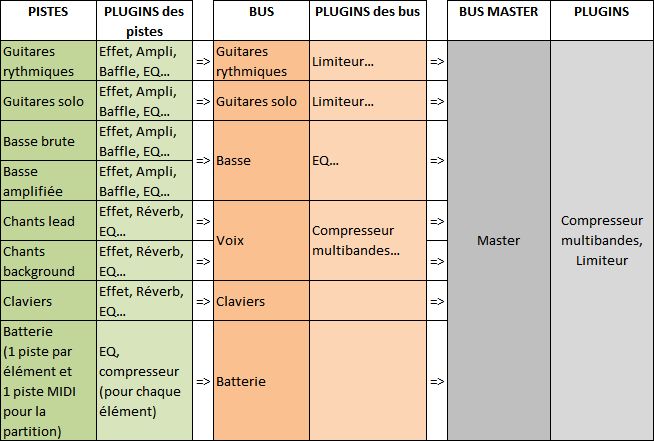





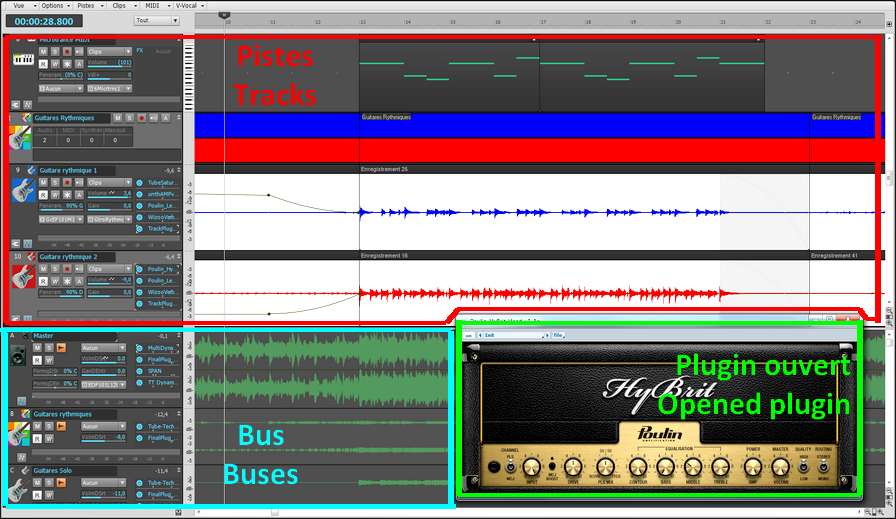


Recording an acoustic real drum kit is far from being easy, even for professional sound engineers. It a time-consuming process, it's frequent to spend several hours placing the microphones around the drum elements before you can actually record. But we are in a home studio, and we will have to deal with a software drum kit, based on midi files...
First of all, why start with the drums? The answer is simple, we will use drums as a metronome. The drums sound will guide us and help us follow the tempo. This will allow for an even recording and the song will not speed up or slow down unintentionally. Of course, variations can be interesting and bring some life to an otherwise mechanical tempo, but let's consider that a studio session seeks recording perfection, even though it's only a home studio.
I usually have no idea what my final drum track will sound like. Actually, I only adjust it when the rest of the song is finished. But I still need its metronome function to record all other instruments. Thus, I create a drum track which repeats itself over and over again, and I try to have this loop match what I am about to play (no punk rhythm to record a ballad). For instance, I'll use one of these patterns:
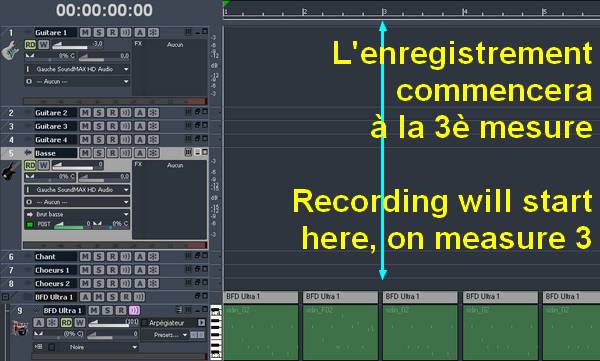

Let's not forget we are recording in a home studio, in an appartment and it is simply impossible to play with a good old 100-watt tube amplifier, without the neigbors calling the police. So we are going to have to record the guitars and the bass directly through the audio interface. No real amplifier, no microphones involved. The latter solution would be preferable, but on of the benefits of direct recording, coupled with amplifier simulators, is that you can always edit the sound later, without having to re-record. Just change the settings and you're done.
So now... bass or guitars first? There isn't one clear answer. Bass and drums are the foundation, the rhythm base of a song and everything else should rely on them. But other factors could also be taken into consideration: for instance, the person recording may be more comfortable with a guitar than a bass, and will rather play guitar first. Or maybe the song has a very important bass riff that compels you to record it first. In any case, you are the one who can decide. If you are uncertain, then the drum / bass duo is a safe bet. If this is in place, then the rest can easily be added.
Guitar or bass, the recording process will be the same. Plug your guitar into the pre-amp, the pre-amp is connected to the audio interface (or plug your guitar directly into the audio interface if using the interface's pre-amp), and set the recording level. This is very important! Before recording anything, check that you are not going to go beyond the maximum level (0 dB, zero decibel). In a home studio, you won't have a sound engineer besides you to make adjustments on the fly, while you are playing. You are the one to take precautions. How can you do that? Simple: try and adjust, it doesn't take long and will prevent you from making a perfect take, then realize the levels were too low or too high, forcing you to do it all over again.
Have a try: for a rhythm guitar for example, play the loudest parts and set the preamp and audio interface volume levels in such way that when you play the loudest, the recording level doesn't go beyond -6 dB. The absolute maximum that you should not reach or go beyond is zero dB. If you play in your try the same way you play during the actual recording, then you can be certain the recording level will be correct. If your average level is between -9 db and -6 dB, then your level is sufficient and you have a margin of error before clipping.
Clipping is the term used to indicate that you reach or go beyond 0 dB. Clipping is your enemy :-)
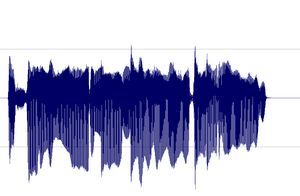
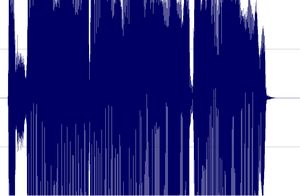
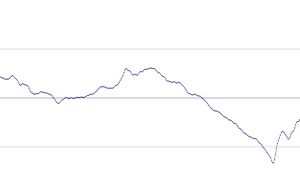
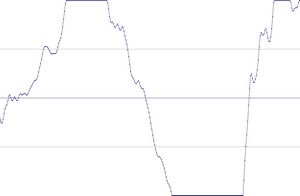

I prefer to record them last but there are no rules. If you prefer to record them first, then do so.
To record vocals, make sure the place is quiet, shut the door, tell the people who live with you to be quiet, and do not record while your neighbor is drilling holes through his kitchen walls! Also, turn off your monitors and use a headset instead to avoid recording the playback with your microphone.
Condenser or dynamic microphones?
Dynamic microphones are solid, they don' need a power source, they can take heavy acoustic pressure (like a kick drum or a saxophone) and they are not too expensive. They are also less sensitive to surrounding noises than condenser microphones. The cons are they lack clarity in the high range, which renders takes less clear and defined than with condenser microphones. They can be used with Jack or XLR plugs.
Condenser microphones are much more responsive and accurate. Their high sensitivity is double-edged, because they will capture any noise when recording. The fans of your PC are noisy? Chances are this noise will be recorded. Sound comes out of your headset? It will be recorded by your condenser microphone. Children are loudly playing outside? You might get that too. However, some condenser microphones are called "cardioid", or "hyper cardioid", and they only record what comes from a specific direction, ignoring (more or less) other sound sources from other directions. On the contrary, omnidirectional microphones record what comes from anywhere. Not ideal for a home studio. Condenser microphones are also more fragile (don't knock them) and must be powered through a "phantom power", whose standard is 48 volts. This kind of power is either present on your audio interface and can be turned on and off with a button, or it will require the use of an external phantom power source that you will then connect to your audio interface. You have to use 3-pin XLR plugs that carry the phantom power current. Finally, condenser microphones are usually rather expensive, some of them cost several thousand euros (or dollars, or pounds), but only professional studios or rich amateurs can afford those. On the plus side, the sound you get with a condenser microphone will have the best quality.
Be cautious though, a good dynamic microphone is worth better than a bad condenser microphone. No big secret here, for microphones like for anything else, very low prices are rarely synonymous with good quality.
A few known and renowned microphone brands: AKG, Milab, Neumann, Rode, Sennheiser, Shure...
Some pieces of advice: buy a microphone stand and a pop filter (you can also make one yourself with wire and a piece of tights from your wife / girlfriend / mother / daughter / neighbor). The stand will prevent you from manually holding your microphone and thus produce handling noises. As for the pop filter, it prevents the air to hit the microphone and produce unwanted blowing sounds when you pronounce some letters such as "p" or "b".
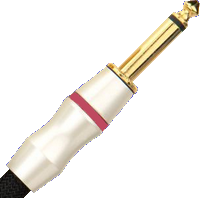
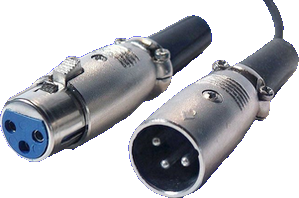
Jack plug (left) and XLR (right)
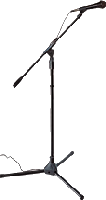


No need to go on and on forever, recording is rather easy. As long as you pay attention to your recording levels and take care over your takes, you should get a satisfying result, good enough to finalize the song

Messages page # 1 2 3 4 5 6 7 8 9 10 11 12 13 14 15 16 17 18 19 20 21 22 23 24 25 26 27 28 29 30 31 32 33 34 35

Fomega
le 21/08/2010 à 00h41
Salut MAN,
Je suis musicien (guitariste harmoniciste) amateur désirant me lancer dans le domaine de la MAO. Je suis vraiment émerveillé par ce travail que je juge titanesque sur ton site. Merci. En visitant certains sites de MAO, je n'ai jamais été autant satisfait que ce soir. J'ai vraiment trouvé mon compte. Bonne continuation MAN. Bon boulot...
* * * * * * * * * * * * * * * *
<em>Grebz : Voilà qui me fait super plaisir ! Ravi de pouvoir aider, au moins un peu.</em>

Glagla
le 20/08/2010 à 14h27
Un grand Merci !!
Je monte mon 1er home studio... Habitué des vrais studios et tables analogiques, je suis (j'étais ..) perdu pour choisir les softs et le hardware.
Je ne connaissais pas ces sim d'ampli gratuites, le matos dont tu parles rentre dans mon raisonnable budget et tes explications claires me confortent dans mes choix.
Merci.
* * * * * * * * * * * * * * * *
<em>Grebz : De rien, content que mes propres galères aujourd'hui résolues puissent aider d'autres personnes !
Bonne continuation musicale !</em>

Honeys
le 05/07/2010 à 17h40
Salut,
J''ai noté une grosse erreur au début quand tu dis que tu enregistres en 48 khz, c'est tout ce qu'il ne faut pas faire, parce que le gain de qualité est absolument inexistant mais par contre le calcul pour revenir en 44,1 est beaucoup plus complexe que de passer de 88,2 à 44,1 (division par 2), le 48 khz et le 96 khz sont utilisés en video uniquement, jamais en musique, donc si on enregistre en suréchantillonnage, on se met en 88,2 khz et c'est tout. Et encore, ce n'est pas non plus très utile parce que ça sert juste à repousser l'effet d'aliasing sur des fréquences qui ne seront de toute facon pas audibles (on enregistre avec un échantillonnage 2 fois supérieur à la fréquence de note la plus aiguë qu'on va enregistrer).
Or, au-delà de 20 khz et meme avant on n'entend plus rien, d'où la norme fixée à 44,1 KHz). Donc si on enregistre à plus de 44,1 KHz, ça veut dire qu'on s'occupe des fréquences situées après 20 khz, donc inutiles.
Après, je dis ça mais j''enregistre en 88,2 khz, mais c'est plus par principe parce que j'ai de la place que par réelle nécessité.
Mais en tout cas un truc est sûr, ne pas enregistrer en 96 KHz et encore moins en 48 khz car on a plus de perte à la conversion qu'autre chose :-)
* * * * * * * * * * * * * * * *
<em>Grebz : Oui, c'est vrai, le standard de la musique sur CD est de 44,1 KHz. Il est donc plus logique d'enregistrer en 44,1 ou dans son multiple 88,2 KHz.
Cela dit, ceci est surtout valable si l'on enregistre ensuite sur CD... Or, le CD n'est pas systématiquement le support final. Beaucoup de gens n'écoutent plus que du MP3 ou du OGG, ou d'autres formats compressés et là, la fréquence d'enregistrement n'a plus d'importance.
Un fichier WAV en 48 KHz converti en MP3 donnera un MP3 à 48 KHz et un certain nombre de Kbits/s choisi par la personne qui fera la conversion.
Je rajouterai que je n'ai personnellement jamais entendu à l'oreille la moindre perte de qualité entre mon enregistrement de base (48 KHz en 24 bits) et le résultat une fois gravé sur CD (donc à 44,1 KHz en 16 bits).
Peut-être certains entendent-ils une différence, mais je ne connais personne capable de différencier les deux. Peut-être des ingénieurs du son à l'oreille entraînée, c'est possible...
Mais la fréquence choisie importe moins que la profondeur d'échantillonnage. 24 bits plutôt que 16 bits ! Ça c'est une certitude !</em>

CelticBreizh
le 15/04/2010 à 12h16
Concernant la repisse, j'ai vu des vidéos de séance d'enregistrement sur youtube je crois, où la chanteuse portait un casque, sans doute semi ouvert, et dont on avait bouché les deux côtés avec du gros ruban adhésif, genre tape grise. Je pense qu'ils avaient dû ajouter sous le ruban, de la mousse. Bref, peut-être une astuce pour garder ce très bon casque Beyer, mais chacun fait comme il l'entend, l'essentiel est de partager et c'est ce que fait Grebz à travers son site. Sans flatterie aucune, qu'il en soit vivement remercié.
* * * * * * * * * * * * * * * *
<em>Merci, c'est sympa !
Le Beyer DT990 me sert à tout : écouter de la musique, regarder des films, jouer sur mon PC.
Pour la musique, sa fiabilité me permet de mixer en confiance le soir, sans déranger ni le voisinage, ni ma famille. Je réécoute de toute façon le résultat obtenu sur mes enceintes de monitoring.
Le DT990 a tendance à faire plus ressortir les sons graves que mes enceintes. À partir du moment où je le sais, je peux en tenir compte.</em>

CelticBreizh
le 15/04/2010 à 01h39
Bonjour,
J'ai vu que vous utilisiez un casque Beyer Dynamic DT990, un excellent casque, mais je ne comprends pas comment vous faites pour vous enregistrer (voix) devant un micro statique par exemple. Pour moi, il ne s'agit pas véritablement d'un casque fermé comme le BEYER DT770 PRO 250 OHM. Par contre pour le mixage et l'enregistrement des guitares en direct, sans placement de micros devant les amplis, c'est certainement plus confortable et moins étouffant que le DT770.
* * * * * * * * * * * * * * * *
<em>Bonjour Éric,
Le DT990 est en effet un casque semi-ouvert et laisse passer du son que peut capter un micro statique. En fait, j'utilise généralement mon SM57 dynamique pour enregistrer les voix, ce qui résoud le problème de repisse du casque.
Le SM57 n'est sûrement pas le meilleur micro du monde pour enregistrer des voix, mais le résultat est loin d'être mauvais.
Il m'arrive parfois d'enregistrer des voix avec un micro Rode NT5, micro statique, et j'utilise dans ce cas un autre casque, fermé, un vieux casque hifi de moyenne qualité, mais très largement suffisant pour m'en servir simplement en monitoring le temps d'un enregistrement.
Je n'enregistre jamais mes guitares avec des micros, je passe toujours en direct en branchant mes guitares (électriques ou électro-acoustiques) sur l'interface audio, via un préampli. L'utilisation d'un casque est donc inutile dans ce cas.
Grebz</em>
